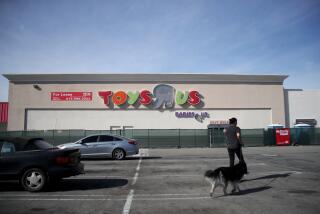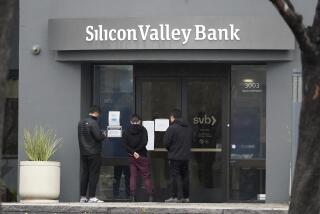American S&L; to Post Healthy Earnings Figures : Thrifts: The once-ailing Stockton firm generated more net income in 1989 than any other S&L; in California.
- Share via
American Savings, the once-ailing California thrift that came within a shade of going out of business, is expected to disclose today that it earned a whopping $214.2 million in its first full year following its government-assisted acquisition by Texas billionaire Robert M. Bass.
According to financial information obtained by The Times, Stockton-based American in 1989 generated more net income than any other savings and loan in California. Comparing American’s net income figure to other institutions, however, is misleading because of the thrift’s special, complex tax situation.
Still, the deal Bass made to acquire American in December, 1988, was clearly a good one. He already has earned back a healthy chunk of the $400 million he invested. That includes $350 million he put into the S&L;, with another $50 million spent on acquisition costs.
However, American’s strong performance could cause some sticky problems in Congress, where some members are complaining that deals regulators made to sell sick thrifts in 1988 were too generous.
Most of the criticism has centered on the acquisition of some failed Texas thrifts by investor Ronald O. Perelman, who some estimate got a spectacular 170% return on his $160-million investment. The newly formed Resolution Trust Corp., under a provision in last year’s thrift bailout bill, is set to review all transactions made by regulators in getting rid of sick thrifts in 1988 and early 1989, including the Bass and Perelman deals, to determine how good a deal taxpayers got.
The Bass group owns 70% of American, with the government effectively owning the other 30% through warrants it holds. American had $16.3 billion in assets at year-end, and is believed to rank about ninth among the largest thrifts nationwide.
With 70% ownership, the Bass group’s share of American’s earnings would be about $150 million, meaning that its return on equity was a strong 37.5%. The group’s profit, however, will not be distributed to it, but rather will be pumped back into the thrift through retained earnings.
American’s return on assets, a key gauge of performance, was about 1.35%, meaning that the thrift earned $1.35 for every $100 in assets. A return of 1% or more is considered strong.
An American spokesman declined to comment Thursday. In an interview last month, American Chief Executive Mario J. Antoci hinted that the thrift’s results would be much better than expected. Antoci attributed it to such factors as sharp cost cutting, lower interest rates that cut the amount American paid for deposits, and $8 million in a pretax gain on the sale of some fixed-rate mortgages the thrift held when Bass took over.
The earnings would have been even higher had it not been for problems stemming from American’s purchase of nearly $500 million in risky, high-yield junk bonds in the spring, including some issued by Robert Campeau’s troubled retailing empire. The numbers to be released today show that American set aside $65 million in provisions for losses on its junk bonds. American has since sold more than $100 million of them.
The thrift reform bill requires S&Ls; to divest junk bonds by 1994. The recent sag in the junk market has forced several thrifts to set aside money for potential losses.
Formerly the nation’s largest S&L;, American ran into turmoil under Charles W. Knapp in 1984 when it was part of his Financial Corp. of America. Knapp was later replaced, and regulators sold American to the Bass group in December, 1988, in a $1.7-billion assistance package, putting its problem assets into a separate “bad bank” whose assets are being sold.
The numbers are subject to a final audit by American’s auditors. Besides stronger operations, American’s overall profit was high because of its tax situation. Under the agreement between regulators and the Bass group, American does not pay taxes on its income as most thrifts do. Instead, each year a portion--$64 million last year--is sent to a holding company called New American Capital. Over a 10-year period, the bulk of the funds collected by New American Capital goes to an offshoot of the Federal Deposit Insurance Corp.
Not everything has gone smoothly for American. Regulators, citing new rules under the thrift bailout, eliminated some accounting sweeteners that wiped out about $300 million in American capital, the financial buffer thrifts have against losses. That may hinder American’s growth.
Nonetheless, American still meets all of the new tough federal standards. Its tangible capital--the basic measurement of how much money is there to protect against losses--is 3.01%, double what is required. It also has nearly double the capital it needs under a new measurement that weighs the riskiness of a thrift’s assets.
The one problem is its “core capital,” a measurement that also includes an intangible asset called goodwill. American has 3.01%, barely meeting the 3% standard.
More to Read
Inside the business of entertainment
The Wide Shot brings you news, analysis and insights on everything from streaming wars to production — and what it all means for the future.
You may occasionally receive promotional content from the Los Angeles Times.










